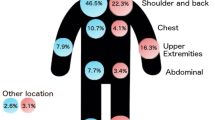Abstract
Background: Age of patients with melanoma varies directly with mortality and inversely with the presence of sentinel lymph node (SLN) metastasis. To gain further insight into this apparent paradox, we analyzed the relationship between age and other major prognostic factors.
Methods: The Sunbelt Melanoma Trial is a prospective, randomized study with 79 institutions involving SLN biopsy for melanoma. Eligible patients were 18 to 70 years old with melanoma of ≥1.0-mm Breslow thickness and clinically N0 regional lymph nodes. SLNs were evaluated by serial histological sections and immunohistochemistry for S-100 protein.
Results: A total of 3076 patients were enrolled in the study, with a median follow-up of 19 months. Five age groups were examined: 18 to 30, 31 to 40, 41 to 50, 51 to 60, and 61 to 70 years. Trends between age and several key prognostic factors was identified: as age group increased, so did Breslow thickness (analysis of variance; P < .001), the incidence of ulceration and regression, and the proportion of male patients (each variable: χ2, P < .001). The incidence of SLN metastasis, however, declined with increasing age (χ2; P < .001).
Conclusions: As age increases, so does Breslow thickness, the incidence of ulceration and regression, and the proportion of male patients—all poor prognostic factors. However, the frequency of SLN metastasis declines with increasing age. It is not known whether this represents a decreased sensitivity (higher false-negative rate) of the SLN procedure in older patients or a different biological behavior (hematogenous spread) of melanomas in older patients.
Similar content being viewed by others
References
Balch CM, Soong SJ, Gershenwald JE, et al. Prognostic factors analysis of 17,600 melanoma patients: validation of the American Joint Committee on Cancer melanoma staging system. J Clin Oncol 2001;19:3622–34.
Austin PF, Cruse CW, Lyman G, et al. Age as a prognostic factor in the malignant melanoma population. Ann Surg Oncol 1994;1:487–94.
Statius Muller MG, van Leeuwen P, de Lange-de Klerk E, et al. The sentinel lymph node status is an important factor for predicting clinical outcome in patients with stage I or II cutaneous melanoma. Cancer 2001;91:2401–8.
McMasters KM, Wong SL, Edwards MJ, et al. Factors that predict the presence of sentinel lymph node metastasis in patients with melanoma. Surgery 2001;130:151–6.
McMasters KM. The Sunbelt Melanoma Trial. Ann Surg Oncol 2001;8(9 Suppl):41S–43S.
McMasters KM, Reintgen DS, Ross MI, et al. Sentinel lymph node biopsy for melanoma: how many radioactive nodes should be removed? Ann Surg Oncol 2001;8:192–7.
Schuchter L, Schultz DJ, Synnestvedt M, et al. A prognostic model for predicting 10-year survival in patients with primary melanoma. Ann Intern Med 1996;125:369–75.
Loggie B, Ronan SG, Bean J, Das Gupta TK. Invasive cutaneous melanoma in elderly patients. Arch Dermatol 1991;127:1188–93.
Kemeny MM, Busch E, Stewart AK, Menck HR. Superior survival of young women with malignant melanoma. Am J Surg 1998;175:437–45.
Stidham KR, Johnson JL, Seigler HF. Survival superiority of females with melanoma. Arch Surg 1994;129:316–24.
MacKie RM, Hole D, Hunter JA, et al. Cutaneous malignant melanoma in Scotland: incidence, survival and mortality, 1979–94. BMJ 1997;315:1117–21.
Gershenwald JE, Thompson W, Mansfield PF, et al. Multi-institutional melanoma lymphatic mapping experience: the prognostic value of sentinel lymph node status in 612 stage I or II melanoma patients. J Clin Oncol 1999;17:976–83.
McMasters KM. Editorial comment on: Kemeny MM, Busch E, Stewart AK, Menck HR. Superior survival of young women with malignant melanoma. Am J Surg 1998;175:444.
Starz H, Balda BR, Kramer KU, Buchels H, Wang H. A micromorphometry-based concept for routine classification of sentinel lymph node metastases and its clinical relevance for patients with melanoma. Cancer 2001;91:2110–21.
Carlson GW, Murray DR, Thourani V, Hestley A, Cohen C. The definition of the sentinel lymph node in melanoma based on radioactive counts. Ann Surg Oncol 2002;9:929–33.
McMasters KM, Reintgen DS, Ross MI, et al. Sentinel lymph node biopsy for melanoma: controversy despite widespread agreement. J Clin Oncol 2001;19:2851–5.
Balch CM, Buzaid AC, Soon SJ, et al. Final version of the American Joint Committee on Cancer Staging system for cutaneous melanoma. J Clin Oncol 2001;19:3635–48.
Gamel JW, George SL, Edwards MJ, Seigler HF. The long-term clinical course of patients with cutaneous melanoma. Cancer 2002;95:1286–93.
Langley RGB, Fitzpatrick TB, Sober AJ. Clinical characteristics. In: Balch CM, Houghton AN, Sober AJ, Soong SJ, eds. Cutaneous Melanoma. 3rd ed. St. Louis: Quality Medical Publishing, 1998: 15–6.
Jaroszewski DE, Pockaj BA, DiCaudo DJ, Bite U. The clinical behavior of desmoplastic melanoma. Am J Surg 2001;182:590–5.
Demierre MF. Thin melanoma and regression, thick melanomas and older men. Arch Dermatol 2002;138:678–82.
Guitart J, Lowe L, Peipkorn M, et al. Histological characteristics of metastasizing thin melanomas. Arch Dermatol 2002;138:603–8.
Caggiati A, Potenza C, Gabrielli F, Passarelli F, Tartaglione G. Sentinel node biopsy for malignant melanoma: analysis of a four-year experience. Tumori 2000;86:332–5.
Author information
Authors and Affiliations
Corresponding author
Rights and permissions
About this article
Cite this article
Chao, C., Martin, R.C.G., Ross, M.I. et al. Correlation Between Prognostic Factors and Increasing Age in Melanoma. Ann Surg Oncol 11, 259–264 (2004). https://doi.org/10.1245/ASO.2004.04.015
Received:
Accepted:
Issue Date:
DOI: https://doi.org/10.1245/ASO.2004.04.015




